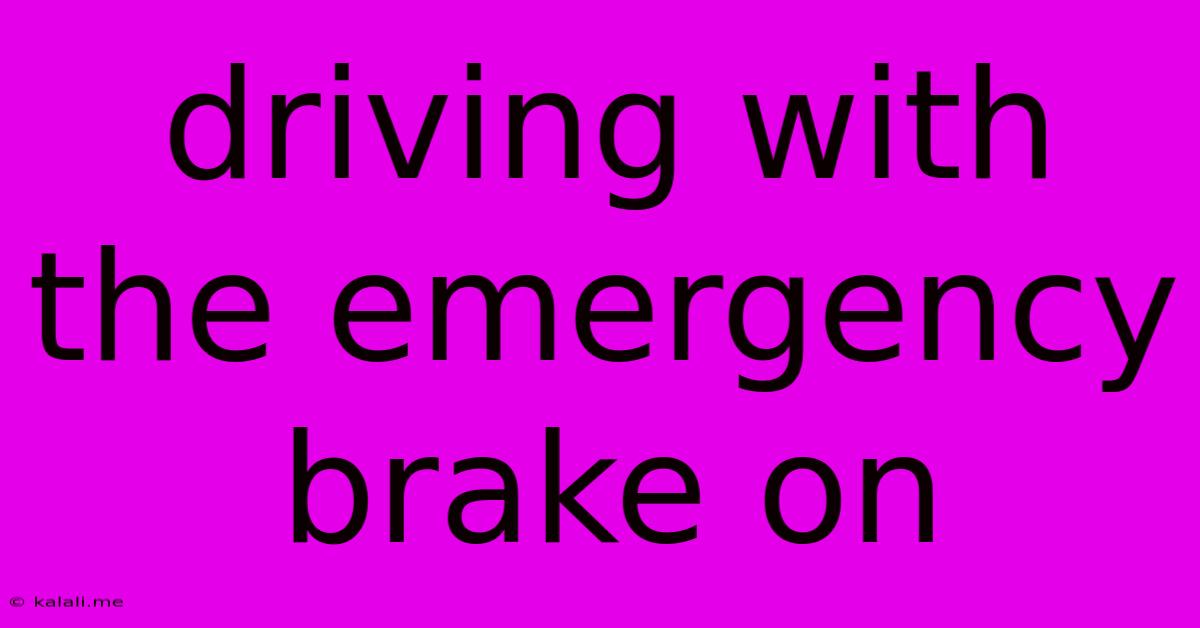Driving With The Emergency Brake On
Kalali
May 24, 2025 · 3 min read

Table of Contents
The Perils of Driving with Your Emergency Brake Engaged: A Comprehensive Guide
Driving with your emergency brake engaged might seem like a minor oversight, but it can quickly escalate into a dangerous and costly situation. This guide will explore the potential consequences, causes, and how to address this issue safely. Understanding the risks associated with driving with the parking brake on is crucial for every driver.
What Happens When You Drive with the Emergency Brake On?
Driving with the emergency brake engaged puts unnecessary strain on various vehicle components. Here's a breakdown of the potential problems:
-
Overheating Brakes: The most immediate and obvious consequence is the significant overheating of your rear brakes (or all brakes, depending on your vehicle's system). This can lead to brake failure, reduced braking efficiency, and potentially a dangerous loss of control. Excessive heat can warp brake rotors and damage brake pads, requiring costly repairs.
-
Transmission Damage: The added resistance caused by the engaged emergency brake can severely damage your transmission, especially in automatic vehicles. The transmission will force itself to work harder, leading to premature wear and tear, potentially requiring a complete transmission overhaul.
-
Tire Damage: The friction created by the locked wheels can cause tire wear and even lead to blown tires. This is particularly true if you're driving at higher speeds or for extended periods with the brake engaged.
-
Steering Problems: The drag from the emergency brake can make steering difficult, especially at low speeds. This can lead to loss of control and potentially accidents.
-
Smoke and Burning Smell: One of the most noticeable indicators is a burning smell emanating from the rear wheels. This is a clear sign that your brakes are overheating and you need to stop immediately.
Why Does This Happen?
Several factors can contribute to accidentally driving with the emergency brake engaged:
-
Forgetting to Release the Brake: This is the most common cause. It's easy to forget, especially if you're distracted or in a rush.
-
Faulty Emergency Brake Mechanism: In some cases, the emergency brake itself might be malfunctioning, failing to fully disengage. This requires professional inspection and repair.
-
Shifting from Park to Drive (Automatic): In some vehicles, a driver might accidentally not fully release the emergency brake before shifting into drive.
-
Improper Adjustment: An improperly adjusted emergency brake can sometimes engage partially without the driver's knowledge.
What to Do If You Think You're Driving with the Emergency Brake On
-
Immediately Release the Brake: If you suspect your emergency brake is engaged, carefully and slowly release the lever or button.
-
Check for Signs of Overheating: Inspect your rear wheels for excessive heat or smoke. If present, stop immediately and allow the brakes to cool.
-
Pull Over Safely: Find a safe place to pull over and assess the situation. Check your brake fluid level and look for any visible damage.
-
Seek Professional Assistance: If you've been driving with the brake engaged for a significant period or notice any damage, it's best to have your vehicle checked by a mechanic. Ignoring the problem can lead to more extensive and costly repairs.
Driving with your emergency brake engaged is a serious issue that can have severe consequences. Being aware of the potential problems, understanding the causes, and knowing what to do if you suspect it's engaged can help ensure your safety and protect your vehicle from damage. Remember to always double-check before driving and be mindful of your vehicle's condition.
Latest Posts
Latest Posts
-
How Many Miles Can You Drive On A Spare Tire
May 24, 2025
-
Wiring Diagram For Light Switch And Outlet On Same Circuit
May 24, 2025
-
How To Fix A Leaky Outdoor Faucet
May 24, 2025
-
What Day Did God Create Man
May 24, 2025
-
How Do You Get Rid Of Drain Flies
May 24, 2025
Related Post
Thank you for visiting our website which covers about Driving With The Emergency Brake On . We hope the information provided has been useful to you. Feel free to contact us if you have any questions or need further assistance. See you next time and don't miss to bookmark.